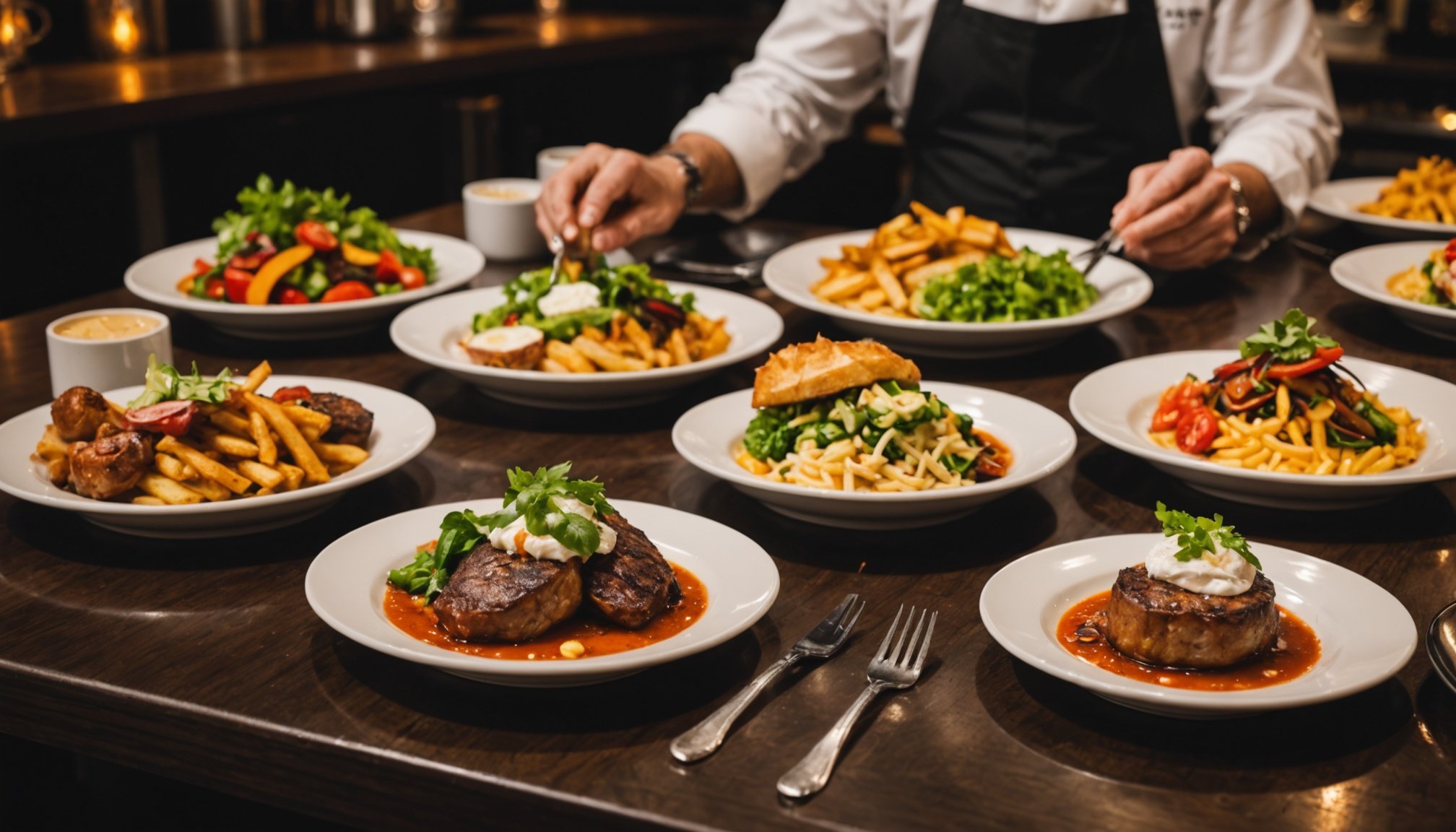Creating themed menus isn't just about food; it’s about crafting unforgettable experiences. This guide explores how to weave storytelling, ambiance, and innovative cuisine into cohesive dining events. Discover practical strategies to captivate your guests, spark conversation, and leave a lasting impression. By the end, you'll be inspired to transform your restaurant into a destination for memorable culinary adventures.
Understanding Themed Menus and Their Importance
Exploring the role and benefits of themed menus in culinary experiences.
Have you seen this : Effective Approaches to Optimize Your Restaurant”s Carbon Footprint
Definition and Role
Themed menus are curated dining experiences that revolve around a specific concept, cuisine, or event. These menus play a crucial role in restaurants by setting the tone for the dining experience and aligning with the establishment's brand. They often include dishes that are creatively designed to reflect the theme, enhancing the overall culinary experience.
Benefits for Customer Engagement
Implementing themed menus can significantly boost customer engagement. By offering a unique and memorable dining experience, restaurants can attract new patrons and retain loyal customers. Themed menus provide a sense of novelty and excitement, encouraging diners to explore and indulge in new flavors. This approach not only enhances customer satisfaction but also increases word-of-mouth promotion.
Additional reading : Green strategies to reduce your restaurant”s carbon footprint for a sustainable future
Successful Implementations
Several restaurants have successfully leveraged themed menus to elevate their culinary experiences. For instance, a renowned seafood restaurant introduced a "Pirate's Feast" menu, complete with nautical-themed dishes and decor. This initiative resulted in a 30% increase in customer visits during the promotion period.
- Benefits of Themed Menus:
- Enhanced customer engagement
- Increased brand recognition
- Higher customer retention rates
Themed menus are a strategic tool for restaurants to differentiate themselves in a competitive market, offering both practical and creative solutions for engaging diners.
Steps to Design a Themed Menu
Crafting a themed menu involves strategic planning and creativity. It's essential to align the menu design with the restaurant's identity and customer expectations.
Identifying the Theme
Choosing a relevant and appealing theme is the first step in menu design. This involves understanding your target audience and researching customer preferences. Consider market trends and seasonal events to ensure that the theme resonates with diners. A well-selected theme can enhance the dining experience and set your restaurant apart.
Creating the Menu Structure
When structuring the menu, balance is key. Aim for a mix of variety and cohesion to keep the offerings interesting yet harmonious. Incorporate seasonal and local ingredients to add authenticity and freshness. This not only showcases culinary themes but also supports sustainable practices.
Visual and Sensory Elements
The presentation of the menu is as important as its content. Use design elements that reflect the theme, such as fonts, colors, and imagery. Beyond the menu itself, enhance the dining experience through ambiance and decor. This creates a cohesive environment that immerses diners in the chosen theme.
- Key Considerations:
- Align theme with brand identity
- Balance menu variety
- Use seasonal ingredients
Focusing on these elements ensures a compelling and memorable themed menu, boosting engagement and satisfaction.
Ingredient Selection and Sourcing Strategies
Elevating themed menus through quality ingredient choices.
Importance of Quality Ingredients
In themed menus, the choice of quality ingredients is paramount. They not only define the taste but also enhance the authenticity of the culinary experience. Selecting superior ingredients ensures that each dish aligns with the theme and meets customer expectations. This focus on quality is crucial for menu development, as it dictates the overall success of the dining concept.
Strategies for Sourcing Unique and Fresh Ingredients
To maintain high culinary standards, restaurants should employ strategic ingredient sourcing methods. This involves seeking out unique and fresh components that complement the theme. Consider establishing partnerships with local suppliers and farmers. Such collaborations can provide a steady supply of seasonal and region-specific ingredients, vital for creating innovative dishes.
Partnerships with Local Suppliers and Farmers
Building relationships with local suppliers not only supports the community but also enhances the menu's authenticity. By sourcing ingredients locally, restaurants can ensure freshness and reduce environmental impact. This approach aligns with the growing consumer demand for sustainability and transparency in food sourcing.
- Key Strategies:
- Prioritize quality in ingredient selection
- Focus on local and seasonal sourcing
- Collaborate with local farmers
These strategies ensure that themed menus are both high in quality and rich in flavor, fostering a memorable dining experience.
Marketing Your Themed Menu
Crafting a themed menu is only part of the journey; menu marketing is crucial for success. Effective promotional strategies can significantly enhance customer outreach and ensure your themed offerings captivate diners.
Building Anticipation
Before the official launch, it's important to create buzz around your themed menu. Pre-launch marketing strategies can include teasers on social media and a targeted email marketing campaign. Utilize visually appealing posts and engaging stories to pique interest. This builds anticipation and encourages potential customers to mark their calendars.
Quote:
"The secret of success in marketing is anticipation."
Consider hosting a preview event for loyal customers or influencers to generate word-of-mouth excitement. This approach not only enhances brand visibility but also fosters a sense of exclusivity and engagement.
Engaging Customers Post-Launch
Once your themed menu is live, maintaining customer engagement is key. Collect feedback and testimonials to understand diner preferences and adjust offerings accordingly. Encourage satisfied customers to share their experiences on social media, amplifying your menu's reach.
Bullet Points for Ongoing Promotion:
- Regularly update content on social media
- Host themed events or contests
- Offer limited-time promotions
These strategies ensure your themed menu remains dynamic and appealing, driving continued interest and customer satisfaction. By focusing on customer outreach, you can sustain engagement and adapt your menu to changing preferences.
Assessing Customer Feedback and Menu Success
Understanding the impact of customer insights on themed menu performance.
Collecting and Analyzing Customer Feedback
Gathering customer feedback is essential for evaluating the success of themed menus. Various methods, such as surveys, comment cards, and online reviews, can provide valuable insights. By analyzing this data, restaurants can identify strengths and areas for improvement. This feedback is instrumental in refining the menu and enhancing customer satisfaction.
Key Performance Indicators for Themed Menu Success
To measure the success of a themed menu, it is crucial to establish clear performance metrics. These indicators might include customer satisfaction scores, repeat patronage rates, and sales figures. Monitoring these metrics helps determine the menu's impact on customer engagement and overall business performance. By focusing on these indicators, restaurants can make informed decisions about menu adjustments.
Quote:
"Listening to customers is the foundation of a successful menu."
Case Studies of Adjustments Based on Feedback
Several restaurants have successfully adapted their menus by integrating customer feedback. For example, a bistro that introduced a Mediterranean-themed menu received feedback about portion sizes. By adjusting the portions, the restaurant improved customer satisfaction and increased repeat visits.
- Key Adjustments:
- Modify portion sizes
- Alter dish presentation
- Introduce new flavors
These examples highlight the importance of feedback in driving continuous improvement and ensuring themed menu success.











